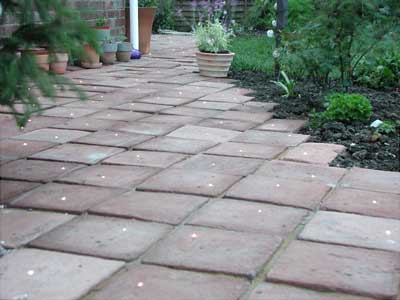Details of a very impressive project were sent to us by A.M. of Cambridgeshire who, in the days before we offered bespoke “Custom” kits, used two of our “Intermediate” lighting kits to create a very attractive garden path lighting effect. That standard Intermediate Star Kit was offered with a 3 metre fibre optic harness, but since this was not long enough for her requirements A. M. specified a customised harness for one of the kits to add an extra 4 metres to the length of the harness.

Today we’d recommend one of our Custom kits – made up to the client’s specific requirement.
The lightsources themselves were installed in a conservatory, adjacent to the path.
A. M. describes how they did the job:
“You may be interested to know that we encased the harness in a hosepipe as you suggested, up to a central distribution point (the standard hosepipe is slightly narrow but it was easy to cut down it and them re-bind it with waterproof tape. We then encased each fibre (singles, twos and a few threes) in electrical earth sheathing, which protected the fibres from the hosepipe end until they entered holes drilled in the slabs (diameter of the sheathing) and also held them vertical in the slab holes.

Finally, once we had set the slabs in the usual way, we sealed each fibre into its slab with Silicone sealant and cut the fibres back to flush with the slabs.
The single and double fibres are bright enough. I probably wouldn’t bother with triple fibres another time. In fact, we changed the bulbs to a 50 watt one each unit, and might even consider going lower*. We decided on two holes per three slabs approximately, so that fixed the number of single/double fibres. More holes would need more fibres, so change the ratio of singles to doubles. Having said that, we are happy with the ratio.
I think the main thing I would impress upon anyone doing something similar was that we spent a long time planning such things as number of holes and how they were arranged in the slabs. Even though they were planned to be random, we planned a scheme out and drilled all the holes in advance.

It was also really important to plan how the fibres were to be laid in the ground. It’s vital to measure all of this out, otherwise you run the risk of fibres not reaching to the furthest holes in slabs.
We didn’t do anything special for the path, but laid the slabs on a good base of sand and then set slabs with cement, embedding the fibres as we went.
Overally we are very pleased with our path – I hope you agree!”
